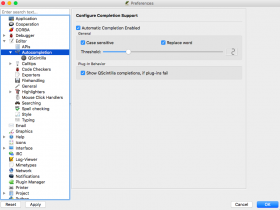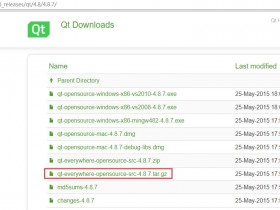The QApplication class manages the GUI application's control flow and main settings.
QApplication contains the main event loop, where all events from the window system and other sources are processed and dispatched. It also handles the application's initialization, finalization, and provides session management. In addition, QApplication handles most of the system-wide and application-wide settings.
For any GUI application using Qt, there is precisely one QApplication object, no matter whether the application has 0, 1, 2 or more windows at any given time. For non-GUI Qt applications, use QCoreApplication instead, as it does not depend on the QtGui library.
The QApplication object is accessible through the instance() function that returns a pointer equivalent to the global qApp pointer. (也就是说,我们在程序里可以直接使用qApp这个变量去调用当前程序的QApplication对象)
QApplication's main areas of responsibility are:
It initializes the application with the user's desktop settings such as palette(), font() and doubleClickInterval(). It keeps track of these properties in case the user changes the desktop globally, for example through some kind of control panel.
It performs event handling, meaning that it receives events from the underlying window system and dispatches them to the relevant widgets. By using sendEvent() and postEvent() you can send your own events to widgets.
It parses common command line arguments and sets its internal state accordingly. See the constructor documentation below for more details.
It defines the application's look and feel, which is encapsulated in a QStyle object. This can be changed at runtime with setStyle().
It specifies how the application is to allocate colors. See setColorSpec() for details.
It provides localization of strings that are visible to the user via translate().
It provides some magical objects like the desktop() and the clipboard().
It knows about the application's windows. You can ask which widget is at a certain position using widgetAt(), get a list of topLevelWidgets() and closeAllWindows(), etc.
It manages the application's mouse cursor handling, see setOverrideCursor()
On the X window system, it provides functions to flush and sync the communication stream, see flushX() and syncX().
It provides support for sophisticated session management. This makes it possible for applications to terminate gracefully when the user logs out, to cancel a shutdown process if termination isn't possible and even to preserve the entire application's state for a future session. See isSessionRestored(), sessionId() and commitData() and saveState() for details.
Since the QApplication object does so much initialization, it must be created before any other objects related to the user interface are created. QApplication also deals with common command line arguments. Hence, it is usually a good idea to create it before any interpretation or modification of argv is done in the application itself.
文章的脚注信息由WordPress的wp-posturl插件自动生成

 微信扫一扫,打赏作者吧~
微信扫一扫,打赏作者吧~![[整理]how to run flask with pyqt5](http://www.jyguagua.com/wp-content/themes/begin/timthumb.php?src=http://www.jyguagua.com/wp-content/uploads/2021/03/pyqt_flask.png&w=280&h=210&zc=1)


